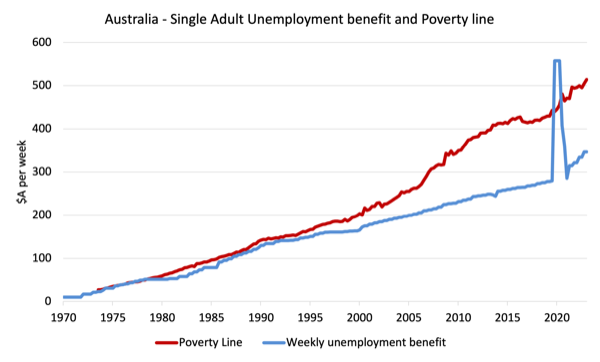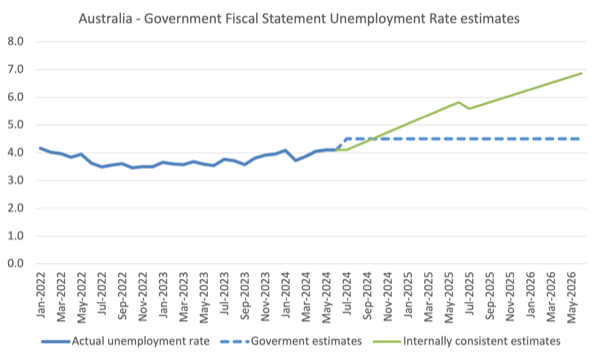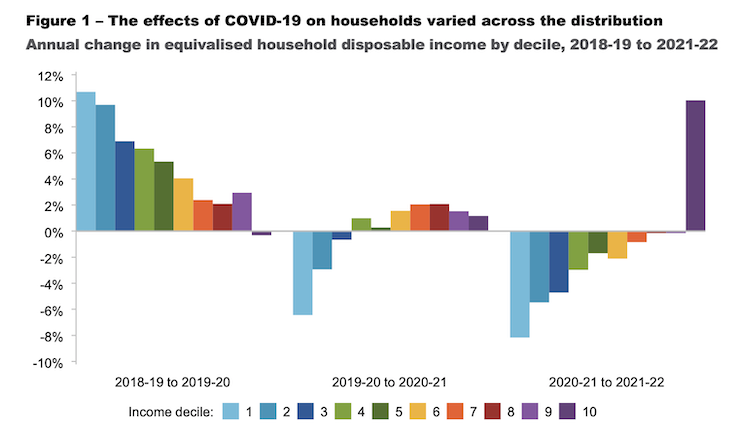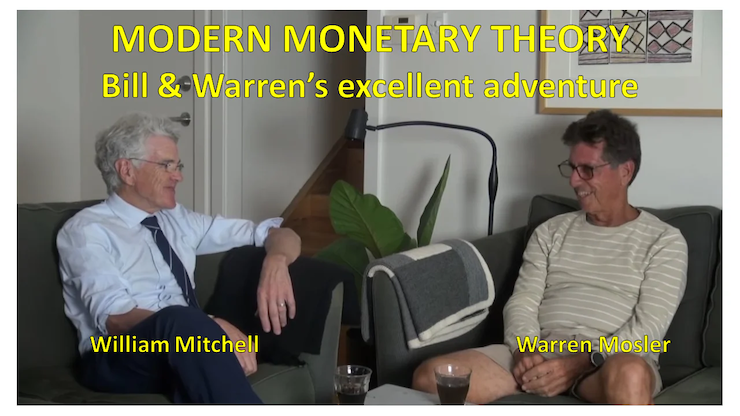[ad_1]
The Australian – Productiveness Fee – was created in 1998 on account of an amalgamation between the Trade Fee (established 1990), the Bureau of Trade Economics (established 1978) and the Financial Planning Advisory Fee (established 1983). As you’ll learn under, its antecedents return to 1921. The Fee is one in all many government-funded establishments which have undergone structural shifts over time as their preliminary function turns into redundant, a redundancy that displays the altering dominant ideology of the time. It’s now the federal government’s principal ‘free market’ assume tank that spews out predictable nonsense often – at all times ending with suggestions for extra deregulation and fewer authorities intervention. Its newest providing was launched on Monday (Could 20, 2024) – A snapshot of inequality in Australia – which, in its personal phrases, “supplies an replace on the state of financial inequality in Australia, reviewing the interval of the COVID-19 induced recession and restoration” with a deal with girls, older folks, and First Nation’s peoples. It comprises some fascinating evaluation however falls brief as a result of its fiscal framework, upon which it makes assessments concerning the knowledge that’s made accessible, is mainstream and assumes the Australian authorities has monetary constraints. As soon as they undertake that fiction, then the scope for coverage is proscribed and we find yourself not fixing the issues mentioned.
Final week (Could 14, 2024), the Federal Treasurer delivered the annual – Fiscal Assertion 2024-25 (aka Federal ‘Price range’)- which defines the discretionary fiscal stance over the following 12 months.
I often present an in depth evaluation of this assertion however it’s such a demoralising activity that this 12 months I made a decision to steer clear.
I’m within the final week of finalising the manuscript for my subsequent e-book (with Warren Mosler) that might be revealed on July 15, 2024 (for particulars and pre-order particulars see under) and so I made a decision that my time was higher spent doing that slightly than getting depressed about politicians who have a good time recording a fiscal surplus, which has been enabled as a result of the federal government is squeezing the prosperity (and wealth) from unusual residents and pursuing a deliberate technique to impoverish a number of the most deprived Australians.
There may be nothing to have a good time about that.
The RBA has been attempting to destroy jobs for the final two or so years via their relentless and pointless rate of interest hikes.
The NAIRU, based on the mainstream logic defines the state the place inflation is steady.
I reject the idea and its derivation, however let’s run with it to check its inner consistency.
The RBA has claimed justification for climbing rates of interest though inflation was declining quickly as a result of they claimed that the NAIRU, which is unobservable however estimated via econometric strategies, is round 4.25 per cent.
The official unemployment charge has been effectively under the RBA’s estimate for years now and so based on the NAIRU logic ought to see inflation persevering with to speed up.
However inflation has been declining in Australia since September 2022, at a time when the unemployment charge was very steady at round 3.7 to three.9 per cent.
Which implies that logically, the NAIRU couldn’t be above the present unemployment charge and should be under it.
On that foundation, with inflation in decline, even when we settle for there’s a definable NAIRU that may be measured in some way, the RBA’s narrative is plainly unsuitable.
Which implies that the RBA’s insistence on placing 140,000 further staff onto the unemployment scrap heap has no basis even within the theoretical construction they imagine in.
The Federal authorities is also trapped in the identical false logic.
Within the – Price range Paper No. 1 – launched final week, we be taught that the federal government is forecasting on account of its discretionary fiscal coverage settings that the unemployment charge will rise from its precise degree of three.6 per cent in 2022-23 (common) to 4 per cent by the top of this monetary 12 months (June 2024), then rise to 4.5 per cent over the course of the following 12 months and stay at that elevated degree till the top of 2025-26.
Nonetheless, as common, the Treasury numbers don’t add up when it comes to being internally constant.
If we put the participation charge, employment and underlying inhabitants progress estimates out to 2025-26 collectively within the labour power framework, after which calculate the expansion within the labour power and the implied rise in unemployment, the simulation exhibits the federal government is vastly underestimating the shift in unemployment over its ahead estimates.
The next graph captures this.
The stable (blue) line as much as April 2024 is the precise official unemployment charge.
The dotted line is the Authorities’s ahead estimates as they seem in Price range Paper No. 1.
The stable (inexperienced) line above that’s the projection one will get of the unemployment charge, if we assume underlying inhabitants progress is fixed, and tackle board the Authorities’s ahead estimates of employment progress and the participation charge.
By that projection the unemployment charge on the finish of the fiscal 12 months 2025-26 might be 6.86 per cent, slightly than the Authorities’s projection of 4.5 per cent.
By way of folks, the federal government is projecting that unemployment will rise to 706 thousand in comparison with April 2024 determine of 604.2 thousand, a distinct of simply over 100 thousand.
My projections counsel that complete unemployment will rise to 1,077 thousand.
Fairly a discrepancy.
One other approach of checking this arithmetic is to make use of the rule of thumb from Arthur Okun, which says that for the unemployment charge to stay fixed, GDP progress needs to be equal to the sum of the expansion within the labour power and labour productiveness.
I did some calculations alongside these traces they usually verify the truth that primarily based on the Authorities’s inhabitants and employment progress estimates, the unemployment charge will rise extra considerably than the Authorities’s unemployment ahead estimates.
Employment progress won’t hold tempo with the underlying inhabitants progress.
One factor we all know categorically is that when there may be mass unemployment, it implies that the fiscal deficit is just too low and is failing to shut the spending hole that outcomes from non-government sector spending and saving selections.
Working a fiscal surplus when the labour market is within the present and projected state is callous financial coverage.
There may be much more I may say concerning the Authorities’s present fiscal technique as introduced final week.
However the factor I actually wish to deal with is the remedy of the employees that the Authorities is intentionally (that’s, by alternative) consigning to the jobless queue.
It’s not sufficient for this Authorities simply to create this unemployment via its fiscal surplus technique.
In addition they are intentionally maintaining that rising cohort in abject poverty via their refusal to extend the earnings help pay for the unemployed above the poverty line.
The final time I analysed this sitution was on this weblog submit – The so-called Inclusion Committee that recommends maintaining the unemployed impoverished (April 19, 2023).
There are a lot of references to the analyses that I’ve performed on this subject over a few years.
The state of affairs for the unemployed retains deteriorating.
Which brings me again to the Productiveness Fee report cited within the Introduction.
As background, the Productiveness Fee (PC) began life effectively earlier than the creation in its present type in 1998 and we are able to hint its antecedents again to the creation of the Commonwealth Tariff Board in 1921, which was changed by the Industries Help Fee in 1974, after which absorbed into the Trade Fee in 1990.
The evolving titles of those authorities our bodies tells you that the Productiveness Fee has undergone structural shifts over time that mirror the altering dominant ideology.
That is just like the evolution of the IMF and the World Financial institution.
The previous was a Keynesian outfit till the Nineteen Seventies whence it morphed into front-line, neoliberal assault canine and enforcer, the function it performs at present.
The evolving nature of those organisations comes about as a result of, partially, the unique roles they had been assigned develop into redundant and they also must discover a new perform that befits the ideological outlook.
Within the case of the Productiveness Fee, it started life as a physique to manage the system of tariff safety that was put in place by the Australian authorities within the early Twenties underneath the banner of the ‘toddler trade’ safety.
Australia was industrialising and it was thought the rising manufacturing sector would require assist to develop economies of scale and environment friendly manufacturing.
Within the Nineteen Seventies, the safety was largely withdrawn as neoliberalism began to infest the minds of the polity, and the Board morphed into the Industries Help Fee.
When the neoliberalism turned extra entrenched, the Labor authorities determined it was now not within the enterprise of trade coverage (‘help’) and was extra targeted on deregulation and many others – the physique dropped the Help from the title.
Then as soon as the ‘free market’ narratives had completely subsumed any concept that the federal government may really intervene to help staff and many others, the Productiveness Fee was born.
The PC Report exhibits that:
1. “The years throughout and following the COVID-19 pandemic have seen vital swings in earnings and wealth (the worth of belongings comparable to homes).”
2. “The pandemic lockdowns drove vital non permanent adjustments in employment and an unlimited improve in direct authorities help via packages comparable to JobKeeper and the Coronavirus Complement.”
3. “Inequality in Australia was comparatively steady within the decade main as much as the COVID-19 pandemic, however fluctuated considerably through the COVID-19 induced recession (in mid 2020) and restoration.”
4. “The preliminary interval of the pandemic noticed an unprecedented fall in earnings inequality. The incomes of lower-income households grew quickly in relative phrases on account of the numerous improve in help funds from the Australian Authorities.”
5. “Earnings inequality subsequently elevated because the economic system recovered. Authorities help was phased out and the incomes of low earnings households fell.”
The PC’s Determine 1 summarises the effectiveness of the federal government help through the early years of the pandemic on the completely different earnings deciles.
It’s a stark graph.
By way of wealth inequality, the PC Report concludes:
Wealth inequality (the relative worth of individuals’s belongings like their properties or superannuation) appeared to say no through the pandemic interval. The earnings obtained over the interval meant that households with decrease wealth had been capable of improve their financial savings and scale back their money owed, contributing to a discount in wealth inequality. Home value adjustments through the pandemic additional lowered wealth inequality, as value progress was comparatively increased in areas with decrease costs, comparable to smaller capital cities and regional areas.
There may be much more within the Report which I’ll talk about at a later date.
However the related a part of the PC Report for at present’s theme is that this conclusion:
The preliminary interval of the pandemic noticed an unprecedented fall in earnings inequality. The incomes of lower-income households grew quickly in relative phrases on account of the numerous improve in help funds from the Australian Authorities (determine 1). This included the Coronavirus Complement, which was paid to earnings help recipients, comparable to these receiving JobSeeker and Youth Allowance. JobKeeper funds to lower-income part-time staff additionally contributed to decrease inequality early within the pandemic
interval. Whereas these packages had been essential through the pandemic to help the Australian neighborhood, they had been additionally expensive and never fiscally sustainable in the long run.
And additional on within the Report:
Job losses in the beginning of the pandemic meant that labour earnings for the underside decile decreased considerably. But substantial authorities help funds led to massive will increase within the disposable incomes of low-income households relative to middle- and higher-income households, resulting in an preliminary decline in total earnings inequality … Specifically, recipients of JobSeeker initially obtained an extra $550 per fortnight underneath the Coronavirus Complement, virtually doubling the earlier dimension of the fee …
JobSeeker is the Authorities’s pathetic time period for the unemployment profit.
The next graph exhibits the evolution of the Single Unemployment Profit and the Single Unemployed Poverty Line since 1973 till March-quarter 2023 (the final two quarters for the poverty line are extrapolated primarily based on CPI actions).
I haven’t the time at present to replace this however the state of affairs has not modified considerably within the final 12 months.

The large spike within the unemployment profit is the impression of the federal government help that the PC is referring to.
The Authorities withdrew that help quickly after and returned the unemployment profit to effectively under the poverty line.
The hole between the poverty line and the profit has elevated over time.
When the present authorities was elected in Could 2022 it refused to change the state of affairs in any materials approach.
Now its right-wing neoliberal think-tank, the PC is claiming that the reversal within the earnings help, that had pushed the unemployed above the poverty line for the primary time in practically 4 a long time, was “not fiscally sustainable in the long run.”
A associated footnote within the Report repeats this evaluation after which says:
The fiscal value of JobKeeper alone was $88.8 billion in nominal phrases.
$A88 billion to assist the unemployed transfer above the poverty line.
This Melbourne Age article (Could 14, 2022) – Radioactive: Contained in the top-secret AUKUS subs deal – reported on the AUKUS announcement, which can contain the Australian authorities spending billions on nuclear submarines that might be outdated by the point they’re delivered.
A lot has been fabricated from the $A368 billion sum the Authorities has dedicated, which is a really massive relative dedication in comparison with most massive tasks.
The article quotes the then Treasurer responding to the considerations over the outlay determine as saying:
Every thing is reasonably priced if it’s a precedence … This can be a precedence.
Which actually provides the sport away doesn’t it?
Repeat the numbers:
$A88 billion to assist the unemployed transfer above the poverty line.
$A368 billion to construct some submarines underneath the AUKUS settlement.
The purpose is that the PC provide no justification for the “not fiscally sustainable” conclusion.
They only assert it and depend on our shared ignorance that it’s a huge quantity and authorities can not afford such issues.
The very fact is that the Australian authorities may transfer the unemployed above the poverty line with the stroke of a pc keyboard.
The fiscal injection that will be wanted can be the tiny relative to the general spending plans and wouldn’t make a lot of a dent within the spending hole that the fiscal surplus is making worse.
No-one else would know the distinction but the unemployed and their households would take pleasure in a way more safe life.
The very fact is that the Australian Labor authorities doesn’t prioritise the well-being of the unemployed.
As Labor governments go, they’re a shame.
Conclusion
I additionally famous a UK Guardian report that talked about these points and I received’t hyperlink to it as a result of it simply takes the readers down one other irrelevant rabbit-hole.
It agrees that the federal government ‘may afford’ to enhance the unemployment profit.
Why? Effectively based on the journalist as a result of they may tax some issues extra.
And at that time, the reader is simply getting the ‘authorities can run out of cash’ narrative bolstered.
Pathetic actually.
It’s apparent that authorities has the selection to finish poverty or not.
The interventions through the early years of the pandemic demonstrated that past doubt.
Now, they’re selecting to not scale back poverty but additionally to push extra folks into poverty.
That could be a stunning indictment of a Labor authorities.
Advance orders for my new e-book at the moment are accessible
I’m within the closing levels of finishing my new e-book, which is co-authored by Warren Mosler.
The e-book might be titled: Fashionable Financial Principle: Invoice and Warren’s Glorious Journey.
The outline of the contents is:
On this e-book, William Mitchell and Warren Mosler, authentic proponents of what’s come to be referred to as Fashionable Financial Principle (MMT), talk about their views about how MMT has developed during the last 30 years,
In a pleasant, entertaining, and informative approach, Invoice and Warren reminisce about how, from vastly completely different backgrounds, they got here collectively to develop MMT. They contemplate the historical past and personalities of the MMT neighborhood, together with anecdotal discussions of assorted teachers who took up MMT and who’ve gone off in their very own instructions that depart from MMT’s core logic.
A really a lot wanted e-book that gives the reader with a elementary understanding of the unique logic behind ‘The MMT Cash Story’ together with the function of coercive taxation, the supply of unemployment, the supply of the value degree, and the crucial of the Job Assure because the essence of a progressive society – the essence of Invoice and Warren’s wonderful journey.
The introduction is written by British tutorial Phil Armstrong.
You will discover extra details about the e-book from the publishers web page – HERE.
Will probably be revealed on July 15, 2024 however you may pre-order a duplicate to be sure you are a part of the primary print run by E-mailing: data@lolabooks.eu
The particular pre-order value might be an inexpensive €14.00 (VAT included).
That’s sufficient for at present!
(c) Copyright 2024 William Mitchell. All Rights Reserved.
[ad_2]


